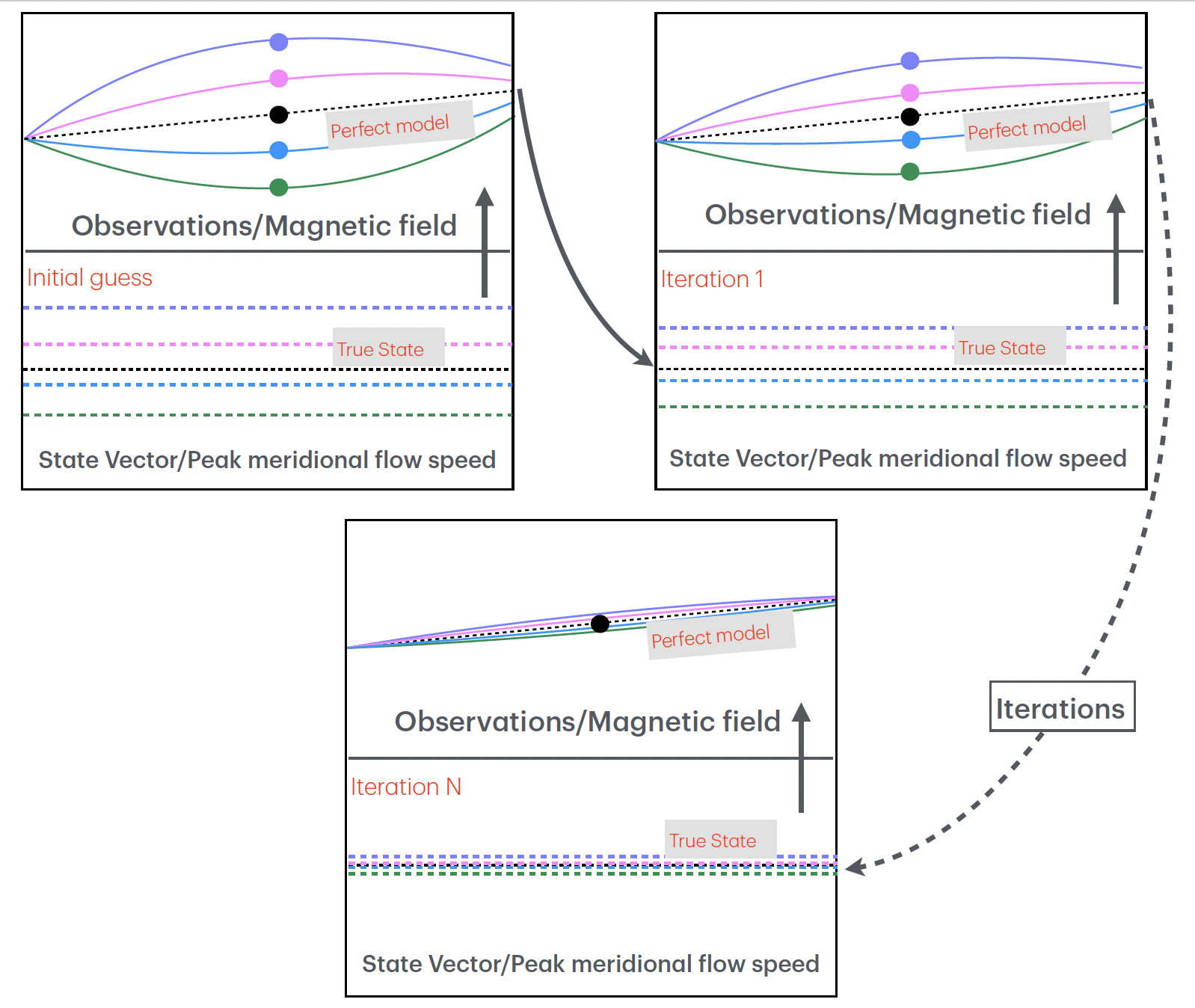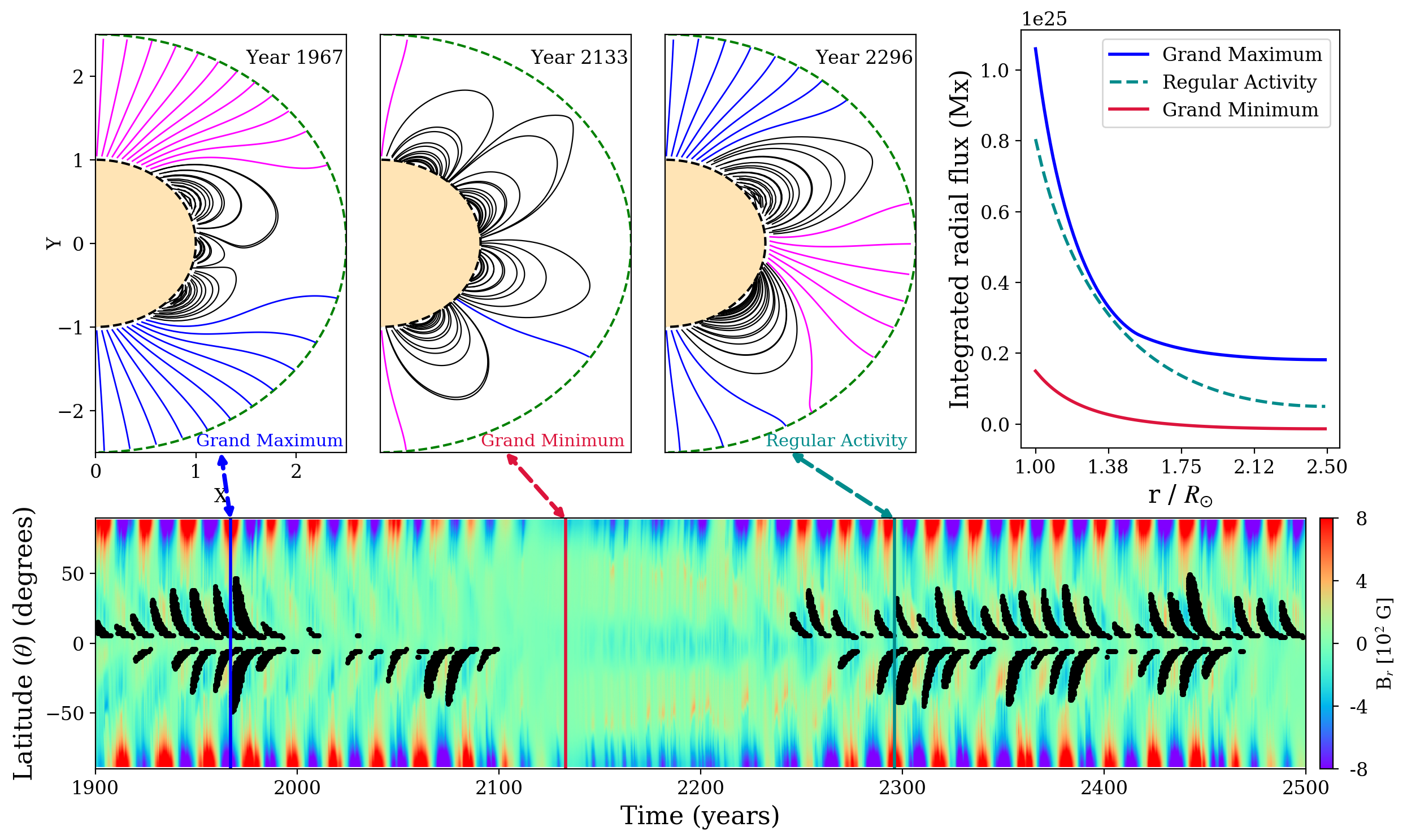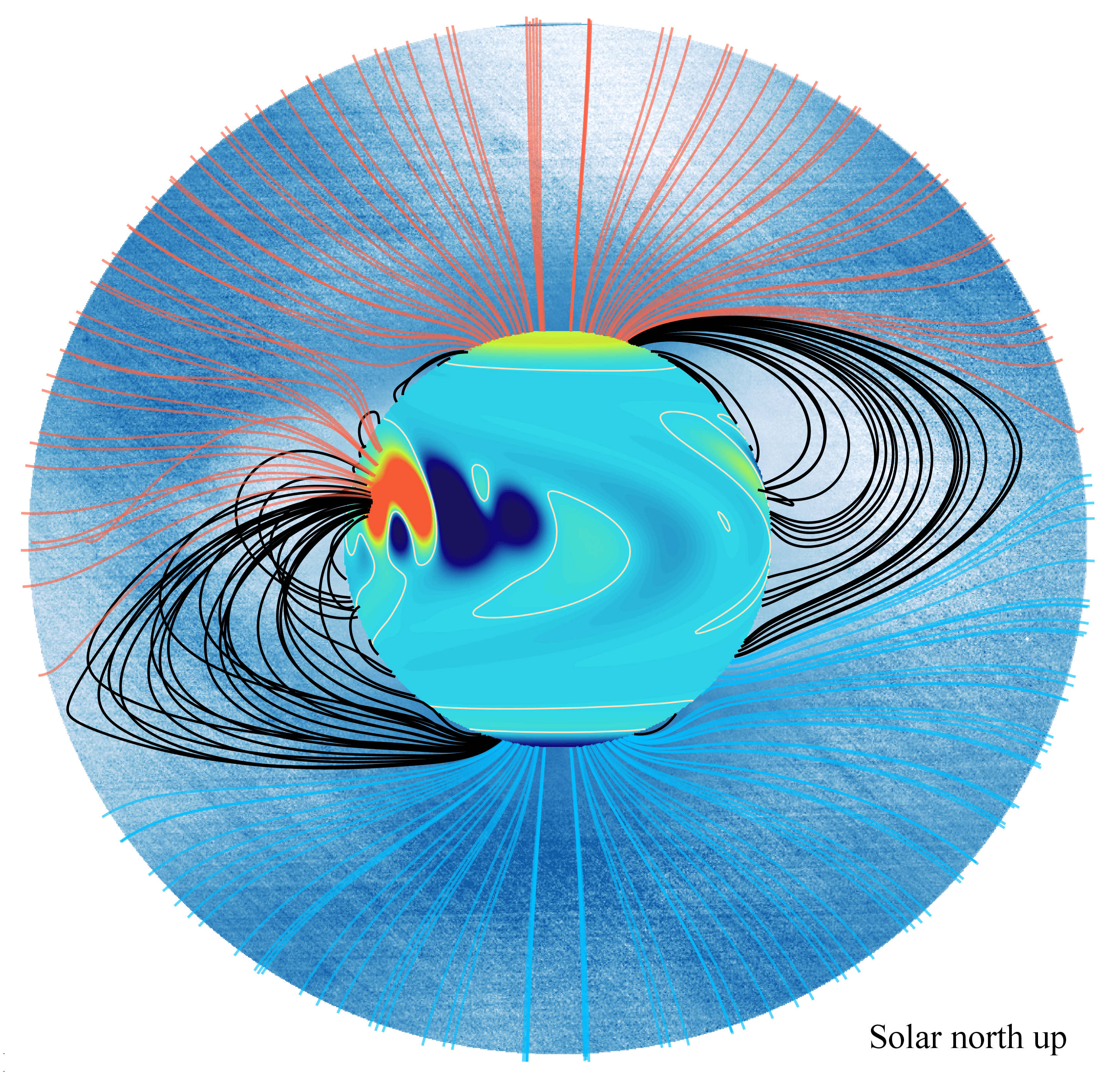Publications
2024
- ApJ
 Ensemble Kalman Filter Data Assimilation into the Surface Flux Transport Model to Infer Surface Flows: An Observing System Simulation ExperimentSoumyaranjan Dash, Marc L. DeRosa, Mausumi Dikpati, and 4 more authorsThe Astrophysical Journal. More Information can be found here , Nov 2024
Ensemble Kalman Filter Data Assimilation into the Surface Flux Transport Model to Infer Surface Flows: An Observing System Simulation ExperimentSoumyaranjan Dash, Marc L. DeRosa, Mausumi Dikpati, and 4 more authorsThe Astrophysical Journal. More Information can be found here , Nov 2024Knowledge of the global magnetic field distribution and its evolution on the Sun’s surface is crucial for modeling the coronal magnetic field, understanding the solar wind dynamics, computing the heliospheric open flux distribution, and predicting the solar cycle strength. As the far side of the Sun cannot be observed directly and high-latitude observations always suffer from projection effects, we often rely on surface flux transport (SFT) simulations to model the long-term global magnetic field distribution. Meridional circulation, the large-scale north–south component of the surface flow profile, is one of the key components of the SFT simulation that requires further constraints near high latitudes. Prediction of the photospheric magnetic field distribution requires knowledge of the flow profile in the future, which demands reconstruction of that same flow at the current time so that it can be estimated at a later time. By performing Observing System Simulation Experiments, we demonstrate how the ensemble Kalman filter technique, when used with an SFT model, can be utilized to make "posterior" estimates of flow profiles into the future that can be used to drive the model forward to forecast the photospheric magnetic field distribution.
2023
- MNRAS
 Long-term forcing of the Sun’s coronal field, open flux, and cosmic ray modulation potential during grand minima, maxima, and regular activity phases by the solar dynamo mechanismSoumyaranjan Dash, Dibyendu Nandy, and Ilya UsoskinMonthly Notices of the Royal Astronomical Society, Nov 2023
Long-term forcing of the Sun’s coronal field, open flux, and cosmic ray modulation potential during grand minima, maxima, and regular activity phases by the solar dynamo mechanismSoumyaranjan Dash, Dibyendu Nandy, and Ilya UsoskinMonthly Notices of the Royal Astronomical Society, Nov 2023Magnetic fields generated in the Sun’s interior by the dynamo mechanism drive solar activity over a range of time-scales. Direct sunspot observations exist for a few centuries; reconstructed variations based on cosmogenic isotopes in the solar open flux and cosmic ray flux exist over thousands of years. While such reconstructions indicate the presence of extreme solar activity fluctuations in the past, causal links between millennia scale dynamo activity, consequent coronal field, solar wind, open flux and cosmic ray flux variations remain elusive; a lack of coronal field observations compounds this issue. By utilizing a stochastically forced solar dynamo model and potential field source surface extrapolation, we perform long-term simulations to illuminate how dynamo generated magnetic fields govern the structure of the solar corona and the state of the heliosphere – as indicated by variations in the open flux and cosmic ray modulation potential. We establish differences in the nature of the large-scale structuring of the solar corona during grand maximum, minimum, and regular solar activity phases and simulate how the open flux and cosmic ray modulation potential vary across these different phases of activity. We demonstrate that the power spectrum of simulated and observationally reconstructed solar open flux time series are consistent with each other. Our study provides the theoretical foundation for interpreting long-term solar cycle variations inferred from cosmogenic isotope based reconstructions and establishes causality between solar internal variations to the forcing of the state of the heliosphere.
- JASTPCausality in heliophysics: magnetic fields as a bridge between the Sun’s interior and the Earth’s space environmentDibyendu Nandy, Yoshita Baruah, Prantika Bhowmik, and 9 more authorsJournal of Atmospheric and Solar-Terrestrial Physics, Jul 2023
Our host star, the Sun, is a middle-aged main sequence G type star whose activity varies. These variations are primarily governed by solar magnetic fields which are produced in the Sun’s interior via a magnetohydrodynamic dynamo mechanism. Solar activity manifests across different timescales, spanning transient phenomena such as flares, energetic particle events and coronal mass ejections to short to long-term modulation of solar irradiance, plasma winds, open flux and cosmic ray flux in the heliosphere. Collectively, these phenomena define space weather and space climate, which impact the state of the near-Earth space environment, the Earth’s magnetosphere, atmosphere and our space-reliant technologies. Understanding physical processes that are at the heart of solar variability and which causally connect the Sun-Earth system is therefore of immense importance to humanity. Such understanding leads to predictions of the impact of solar activity on our planet and provides a window to explore the plasma universe and other star-planet systems, including assessing the habitability of (exo)planets. In this review, based on our research on the solar-terrestrial system and extant scientific literature, we illuminate processes related to the genesis of solar magnetic fields in the Sun’s interior, their emergence and evolution, their manifestation as solar eruptive events, and their eventual impact on the geospace environment mediated via solar winds and storms. We focus on few phenomena that establish causal connections and demonstrate how our current understanding can lead to development of predictive capabilities encompassing the domain of heliophysics.
2021
- PEPSSolar evolution and extrema: current state of understanding of long-term solar variability and its planetary impactsDibyendu Nandy, Petrus C. H. Martens, Vladimir Obridko, and 2 more authorsProgress in Earth and Planetary Science, Jul 2021
The activity of stars such as the Sun varies over timescales ranging from the very short to the very long—stellar and planetary evolutionary timescales. Experience from our solar system indicates that short-term, transient events such as stellar flares and coronal mass ejections create hazardous space environmental conditions that impact Earth-orbiting satellites and planetary atmospheres. Extreme events such as stellar superflares may play a role in atmospheric mass loss and create conditions unsuitable for life. Slower, long-term evolutions of the activity of Sun-like stars over millennia to billions of years result in variations in stellar wind properties, radiation flux, cosmic ray flux, and frequency of magnetic storms. This coupled evolution of star-planet systems eventually determines planetary and exoplanetary habitability. The Solar Evolution and Extrema (SEE) initiative of the Variability of the Sun and Its Terrestrial Impact (VarSITI) program of the Scientific Committee on Solar-Terrestrial Physics (SCOSTEP) aimed to facilitate and build capacity in this interdisciplinary subject of broad interest in astronomy and astrophysics. In this review, we highlight progress in the major themes that were the focus of this interdisciplinary program, namely, reconstructing and understanding past solar activity including grand minima and maxima, facilitating physical dynamo-model-based predictions of future solar activity, understanding the evolution of solar activity over Earth’s history including the faint young Sun paradox, and exploring solar-stellar connections with the goal of illuminating the extreme range of activity that our parent star—the Sun—may have displayed in the past, or may be capable of unleashing in the future.
2020
- GRL
 Flux Erosion of Magnetic Clouds by Reconnection With the Sun’s Open FluxSanchita Pal, Soumyaranjan Dash, and Dibyendu NandyGeophysical Research Letters, Apr 2020
Flux Erosion of Magnetic Clouds by Reconnection With the Sun’s Open FluxSanchita Pal, Soumyaranjan Dash, and Dibyendu NandyGeophysical Research Letters, Apr 2020Magnetic clouds (MCs) are flux rope magnetic structures forming a subset of solar coronal mass ejections, which have significant space weather impacts. The geoeffectiveness of MCs depends on their properties, which evolve during their interplanetary passage. Based on an analysis of observations spanning two solar cycles, we establish that MCs interacting with the ambient solar wind magnetic field (i.e., heliospheric open flux) lose a substantial amount of their initial magnetic flux via magnetic reconnection, which, in some cases, reduce their geoeffectiveness. We find a linear correlation between the eroded flux of MCs and solar open flux which is consistent with the scenario that MC erosion is mediated via the local heliospheric magnetic field draping around an MC during its interplanetary propagation. The solar open flux is governed by the sunspot cycle. This work therefore uncovers a hitherto unknown pathway for solar cycle modulation of the properties of MCs.
- APJ
 Prediction of the Sun’s Coronal Magnetic Field and Forward-modeled Polarization Characteristics for the 2019 July 2 Total Solar EclipseSoumyaranjan Dash, Prantika Bhowmik, BS Athira, and 2 more authorsThe Astrophysical Journal, Feb 2020
Prediction of the Sun’s Coronal Magnetic Field and Forward-modeled Polarization Characteristics for the 2019 July 2 Total Solar EclipseSoumyaranjan Dash, Prantika Bhowmik, BS Athira, and 2 more authorsThe Astrophysical Journal, Feb 2020On 2019 July 2 a total solar eclipse—visible across parts of the Southern Pacific Ocean, Chile, and Argentina—enabled observations of the Sun’s corona. The structure and emission characteristics of the corona are determined by underlying magnetic fields, which also govern coronal heating and solar eruptive events. However, coronal magnetic field measurements remain an outstanding challenge. Coronal magnetic field models serve an important purpose in this context. Earlier work has demonstrated that the large-scale coronal structure is governed by surface flux evolution and memory buildup, which allows for its prediction on solar rotational timescales. Utilizing this idea and based upon a 51 day forward run of a predictive solar surface flux transport model and a potential field source surface model, we predict the coronal structure of the 2019 July 2 solar eclipse. We also forward model the polarization characteristics of the coronal emission. Our prediction of two large-scale streamer structures and their locations on the east and west limbs of the Sun match eclipse observations reasonably well. We demonstrate that the Sun’s polar fields strongly influence the modeled corona, concluding that accurate polar field observations are critical. This study is relevant for coronal magnetometry initiatives envisaged with the Daniel K. Inouye Solar Telescope, Coronal Multichannel Polarimeter and upcoming space-based instruments such as Solar Orbiter, Solar Ultraviolet Imaging Telescope and the Variable Emission Line Coronagraph on board the Indian Space Research Organisation’s Aditya-L1 space mission.
2018
- APJThe Large-scale Coronal Structure of the 2017 August 21 Great American Eclipse: An Assessment of Solar Surface Flux Transport Model Enabled Predictions and ObservationsDibyendu Nandy, Prantika Bhowmik, Anthony R Yeates, and 3 more authorsThe Astrophysical Journal, Jan 2018
On 2019 July 2 a total solar eclipse—visible across parts of the Southern Pacific Ocean, Chile, and Argentina—enabled observations of the Sun’s corona. The structure and emission characteristics of the corona are determined by underlying magnetic fields, which also govern coronal heating and solar eruptive events. However, coronal magnetic field measurements remain an outstanding challenge. Coronal magnetic field models serve an important purpose in this context. Earlier work has demonstrated that the large-scale coronal structure is governed by surface flux evolution and memory buildup, which allows for its prediction on solar rotational timescales. Utilizing this idea and based upon a 51 day forward run of a predictive solar surface flux transport model and a potential field source surface model, we predict the coronal structure of the 2019 July 2 solar eclipse. We also forward model the polarization characteristics of the coronal emission. Our prediction of two large-scale streamer structures and their locations on the east and west limbs of the Sun match eclipse observations reasonably well. We demonstrate that the Sun’s polar fields strongly influence the modeled corona, concluding that accurate polar field observations are critical. This study is relevant for coronal magnetometry initiatives envisaged with the Daniel K. Inouye Solar Telescope, Coronal Multichannel Polarimeter and upcoming space-based instruments such as Solar Orbiter, Solar Ultraviolet Imaging Telescope and the Variable Emission Line Coronagraph on board the Indian Space Research Organisation’s Aditya-L1 space mission.
